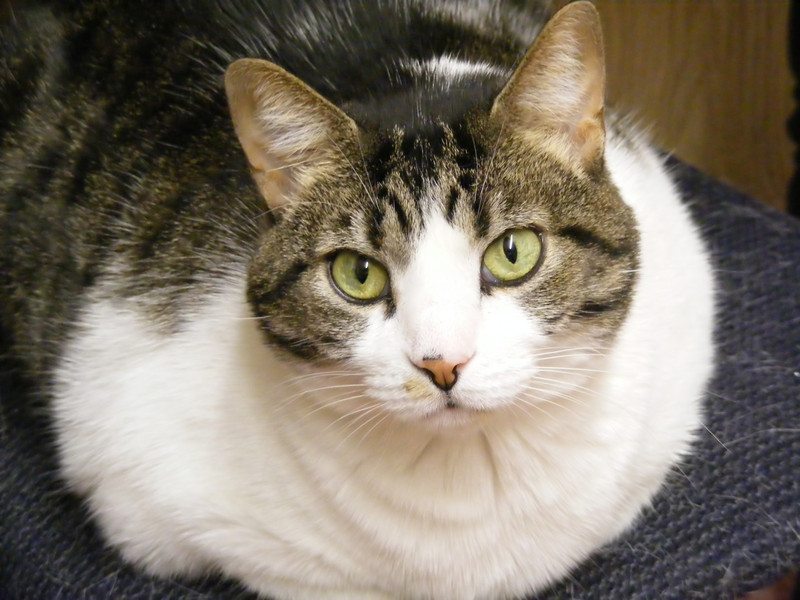
Feline obesity is, unfortunately, a common cat health problem. Obesity causes added stress to the cat’s body, and it increases risks of joint pain, diabetes, heart disease, arthritis, high blood pressure, some cancers, and liver problems. The first thing you need to do is make an appointment with the vet. Your cat needs to be properly weighed and monitored. Your veterinarian can help you in this weight loss process and putting your cat on a diet. This support is indispensable.
How Much to Feed Your Cat to Help Her Lose Weight
This can be the confusing part, but there is help. Your cat’s vet will help you determine how much to feed your cat to help her lose weight. First, you need to know the normal weight of an adult cat, which is 8-10 pounds. Anything over this is considered overweight. When your cat does lose weight she will be re-evaluated by her vet to determine the next steps to either lose more weight or maintain her current weight. According to VCA Animal Hospitals, this is how much you need to feed your cat to help her lose weight:
Ideal Weight Calories per Day
8 pounds 180
10 pounds 210
12 pounds 230
Don’t use this chart if your cat is very overweight. Your vet will help you make a goal that will be easier to reach, because your cat needs to weaned down slowly. For example, taking your feline from 800 calories to 230 calories a day isn’t healthy. Your cat will likely freak out. But taking it down a little at a time will make it easier and healthier. It’s not healthy for us or our cats to lose weight too quickly. If you have one of those cat food containers that constantly lets dry food out into the dish get rid of it! Cats easily overeat, because if the food is there they are going to eat it. With these products cats will eat more than they should. Use smaller portions of wet and dry food about four times a day rather than large portions twice a day. Feeding more often with smaller portions help kitty feel better about the reduced amount of calories. Your vet may also recommend a low calorie brand of cat food. You will also need to ask your vet how much wet food and how much dry food your cat needs. If your cat is reluctant about the food change you can wean her into it. Mix a little of the new food in with her soon-to-be old food and serve. If she’s still not eating it add a teaspoon of tuna juice. Add a little more of the new food each day. This transition can take 1-2 weeks. Dr. Michael Santiago, DVM, recommends feeding your cat wet food only, saying, “A good way to put your cat on a diet is to feed them wet (canned food) and eliminate the dry. Many owners put dry food down and let cats eat it free of choice which promotes grazing and causes them to gain weight. Weight restricted diets work very well provided that the owner knows how much their pets weigh and adjust the intake to avoid gaining weight. Canned foods are mostly moisture and tend to have a higher protein content which in people has been shown to increase their weight loss results while minimizing muscle loss.”
How to Get Your Cat More Exercise
Exercise is important in helping your cat lose weight, too. Encourage more movement. It can be difficult to get your cat to exercise because their nature in the wild is to be mostly immobile until they need to hunt. Then they burst into a fast run to get the prey they’re hunting. Then it’s more rest until the next hunt. So, you really need to encourage this hunt in her to get her moving. If you don’t already, set up a routine play time with your cat for 30-60 minutes every day. Make it at the same time every day. Not only will your cat get some great exercise in, but she’ll expend energy that she might otherwise use to bug you while you’re sleeping. Use a wide variety of toys to encourage her to exercise. Toys you can try include anything on a stick, mice, laser pointers, feather toys, ribbon toys, and anything with catnip in it. Using different stick toys help because it forces you to play with your cat. You need to be there for the duration of play time. Get some stick toys with ribbons, birds, and other interesting things on them. Dr. Jeff Werber, a Los Angeles veterinarian, says, ” During a weight loss program it is important to make regular visits to your veterinarian to make sure your cat remains healthy through the process.” Your vet will schedule regular weigh-ins and check-ups to help you make sure she is continuing to lose weight in a healthy manner. Soon your cat will be healthier and happier, and so will you.
Featured Photo: Thinkstock









